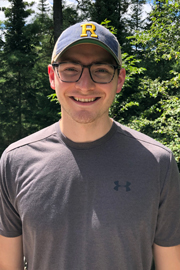GDSC Predoc Tom O’Connor Passes his Qualifying Exam!
Thursday, August 20, 2020

Having recently completed his second year, earlier this month, GDSC Predoc Tom O'Connor passed his Qualifying Exam. Tom is pursuing his Ph.D. research under a co-mentorship with Dr. Robert Dirksen and Dr. Joe Chakkalakal. His doctoral research project is titled "Endurance exercise as a therapeutic intervention to preserve skeletal muscle function post-radiation." His research abstract is sampled below. Congratulations Tom!
Abstract: Exercise has several beneficial effects on overall health, such as increased bone strength and improved cardiovascular, cognitive, and immune system function. Similarly, exercise elicits improved muscle function by increasing muscle stem cell (satellite cell, SC) activation and improving excitation-contraction coupling through the establishment of Ca2+ Entry Units (CEUs) and upregulation of calcium handling genes. However, radiotherapy, a mainstay in the treatment of many cancers, produces multiple adverse effects on skeletal muscle and has been shown to cause early-onset sarcopenia, a condition characterized by significant muscle weakening commonly observed in the elderly. Our studies show that radiation produces cytotoxic effects on SCs, depleting the SC pool and leaving the remaining SCs dysfunctional in their ability to activate and repair injured myofibers. We find that radiation exposure also decreases expression of key Ca2+ handling genes in skeletal muscle including CASQ1, CACNB1, and STIM1. Calsequestrin-1 binds Ca2+ in the sarcoplasmic reticulum (SR), buffering intracellular Ca2+ stores upon muscle excitation-contraction. CACNB1 encodes the b subunit of the 5 subunit dihydropyridine receptor (DHPR), the voltage sensor in the transverse tubule (TT) that activates ryanodine receptor (RyR1) in the SR to release Ca2+ for muscle contraction. STIM1 encodes the stromal-interaction molecule-1, a Ca2+ sensor in the SR, which activates Orai1 Ca2+-permeable channels in the TT when SR Ca2+ stores become depleted, a process known as store-operated calcium entry (SOCE).
The central hypothesis of this project is that post-radiation exercise restores muscle repair and regeneration function through activation of the remaining SC pool, allowing for turnover of damaged myonuclei. We also postulate that endurance exercise restores homeostatic Ca2+ control mechanisms after radiation through upregulation of integral Ca2+ handling genes and establishment of CEUs, overall restoring post-radiation muscle contractile function. I will assess the effect of post-radiation chronic endurance exercise on physiological muscle function using a juvenile radiation mouse model. Aim 1 will characterize SC adaptation in terms of myonuclear contribution and regenerative function post-voluntary wheel running (VWR), the model we will use for chronic endurance exercise. Aim 2 will address how Ca2+ handling is affected by VWR, assessing SOCE, gene expression, and resting calcium levels. Aim 3 will address the effects of radiation on SCs and Ca2+ handling and the therapeutic extent of post-radiation VWR to restore physiological muscle function. The results of these studies will provide novel insight into the patho-mechanisms of radiation-induced sarcopenia and determine the therapeutic potential of chronic endurance exercise to rescue SC regenerative capacity and enhance Ca2+ handling in an attempt to restore overall muscle function.